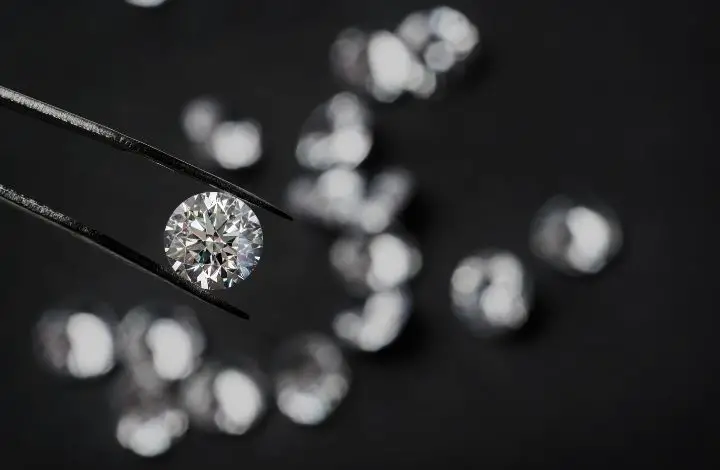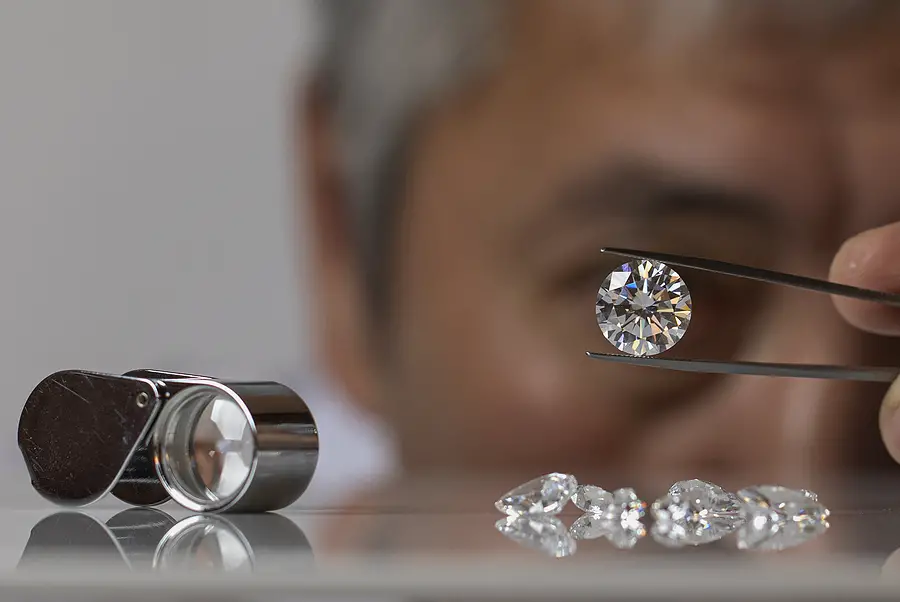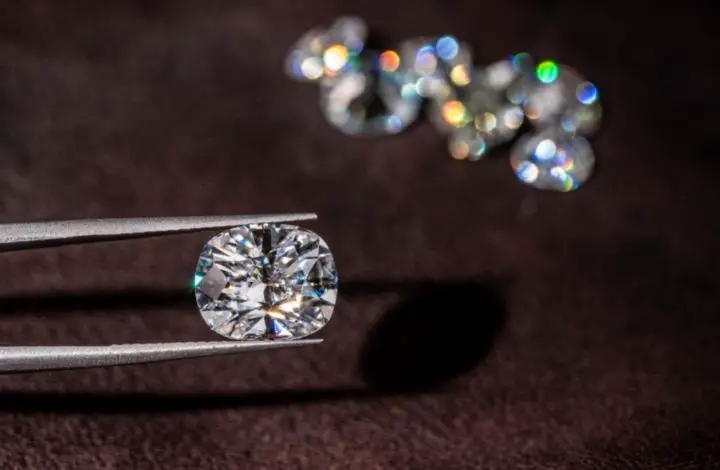Hey There! We may earn a commission from links on this page. This helps support the site and is at no extra cost to you. Thanks!
Top Recommendation:
It is imperative that you buy your lab-grown diamonds from a reputable dealer that offers high-quality photos and diamond certification. We recommend James Allen and Blue Nile for their selection and excellent customer service.
Are you looking for a cost-effective, conflict-free, and environmentally friendly diamond? Then, you might want to consider a lab-grown diamond; they have the same durability and sparkle as a natural diamond but cost 10-30% less. This guide will teach the basics of lab-grown diamonds, the 4Cs, and how to buy a lab-grown diamond online.
Millennials and Generation Z are falling out of love with natural mined diamonds because of their high environmental costs, and guess who the next superstar is? Lab-grown diamonds, of course!
Around 70% of millennials are moving away from conventional diamonds and opting for a lab-grown alternative. Celebrities such as Meghan Markle, Penelope Cruz, Lady Gaga, and others are sporting these guilt-free diamond jewelry pieces.
What is a Lab-Created Diamond?
Lab-created or lab-grown diamonds are diamonds grown in highly controlled laboratory environments using advanced technological processes that imitate the conditions under which a diamond naturally develops.
Lab-created diamonds go by many names, such as synthetic diamonds, engineered or cultured diamonds, along with many others.
It typically takes under a month to grow a diamond in a lab, in contrast to the billions of years it takes to grow a diamond within the Earth. White diamonds take the longest to grow, with upwards of 2 weeks to develop a 1-carat diamond. On the other hand, yellow and blue diamonds take 5-10 days. The growing process cannot be rushed; if the process is rushed, the crystal will fracture.
Are They Real Diamonds?
The one-word answer would be, 'Yes.'
These are REAL diamonds in all aspects - chemically, physically, and optically. The only difference is that they are produced artificially under simulated conditions.
The Federal Trade Commission (FTC) defines a diamond as pure crystallized carbon in the isometric cubic system, whether mined from the Earth or grown in a lab. These manufactured diamonds consist of carbon atoms arranged in the characteristic diamond crystal structure. Since they are made of the same material as natural diamonds, they exhibit the same optical and chemical properties.
Natural and lab-grown diamonds exhibit the same qualities and characteristics:
- Chemical Composition: C
- Crystalline Structure: Cubic
- Refractive Index: 2.42
- Dispersion: 0.044
- Hardness (MOHS): 10
- Density: 3.52
In a nutshell, whether mined or grown in a lab, a diamond is a diamond (irrespective of the way it is formed/produced).

How are Lab-Grown Diamonds Produced?
Natural diamonds formed millions of years ago inside the Earth. Scientists believe this is due to carbon dioxide being exposed to extreme temperatures (2,000+ Fahrenheit) and extreme pressure (about 727,000 pounds per square inch) miles below the Earth's surface. Once formed, diamonds move towards the Earth's surface from its core because of volcanic explosions.
Lab-grown diamonds are manufactured using conditions that imitate the natural processes that create earth-grown diamonds. Carbon is subjected to high temperatures and high pressure in a controlled environment. The result is a 'diamond.'
In labs, two methods are used to grow diamonds:
1. HPHT (High-Pressure High Temperature)
Developed in the 1950s, the HPHT process uses a tiny diamond seed placed into a piece of carbon and exposed to high pressure (about 1.5 million pounds per square inch ) and high heat (over 2000°F). The carbon melts, changing its atomic structure, and forms a diamond around the seed. It is then cooled, and the diamond is formed.
The HPHT process is also used to enhance the color of lab-grown diamonds to make them colorless, pink, green, blue, or yellow.
2. CVD (Chemical Vapor Deposition)
Scientists started experimenting with the CVD method to grow diamonds in the 1980s. This method uses less pressure than the HPHT method and smaller machines, and it has become the go-to production method for colorless diamonds in most laboratories.
The CVD method imitates how diamonds form in interstellar gas clouds (outer space). First, a thin 'seed' diamond is placed inside a vacuum chamber. Next, the chamber is filled with a carbon-rich gas mixture (usually hydrogen and methane) and heated to nearly 1500°F. Under this heat, the gas turns to plasma, causing the release of carbon pieces. These carbon pieces rain down onto the diamond seed, causing the diamond to grow.
The CVD process consistently produces superior Type IIA quality diamonds, which are extremely rare for earth-mined diamonds - 97% of mined diamonds are regular Type I diamonds, which is what you will find at your local jewelry store. Type IIA diamonds are the most chemically pure diamonds, lacking nitrogen and or boron impurities, making them brighter and harder than Type I diamonds.
Which Lab Grown Diamond is Better? HPHT vs. CVD
As fascinating as the technology to create lab-grown diamonds is, and even though both technologies have their pros and cons, luckily, you don't need to think about which method was used to grow your diamond. The beauty of a lab-grown diamond is in its physical characteristics, not the precise method by which it was formed.
Whether created by the HPHT or CVD method, lab-grown diamonds are far superior and more affordable than anything we will ever get out of the Earth. Not to mention they are the most ethical option and are truly conflict-free.
What do Lab-Created Diamonds Cost?
Lab-grown diamonds have the same quality and appearance as natural diamonds but cost from 10 to 50% less.
Lab-grown diamonds (as with natural diamonds) are graded and priced based on cut, color, clarity, and carat weight. The higher the quality of the grades, the higher the price. However, unlike natural diamonds, the cost of lab-grown diamonds does not increase exponentially with carat size. For example, you can get a round-cut, 2-carat lab-grown diamond for about half the price as a natural diamond of the same cut and size.
Consider a lab-grown stone if you want a large diamond for your jewelry piece.
Lab-grown diamonds can also be colored and cost far less than natural fancy colored diamonds. So they are a great option if you want a fancy colored blue or pink diamond but don't want to pay a considerable price.
Lab-grown diamonds are available in fancy colors such as yellow, blue, and pink, allowing you to choose beyond white. In addition, fancy color lab-grown diamonds are offered at a fraction of the cost compared to their earth-mined equivalents and even more significant savings than colorless lab-grown diamonds.
- Fancy Yellow - 75% less
- Fancy Blue - 90% less
- Fancy Pink - 80% less
One downside to lab-grown diamonds is that they have little to no resale value. Unlike natural diamonds, lab-grown diamonds can be made on-demand. In addition, advances in technology are making it easier than ever to grow diamonds, causing the price of lab-grown diamonds to decrease over time. (However, natural diamonds also have little resale or investment value).
Why Should you Buy Lab-Created Diamonds?
A diamond created in a lab is just as real as a mined diamond with the same physical and chemical properties but without the argued and questionable ethical practices of mining natural diamonds. In addition, lab-grown diamonds are often of better quality because they are grown in a controlled, fully monitored environment.
Some of the most significant factors on why should you buy lab-created diamonds include:
- Brighter quality and higher purity standard
- Fewer defects comparatively
- Ethical and environment friendly
- Greater affordability
- Rare natural colored diamonds can be created easily in labs.
- Trackable origin source allows you to source diamonds from reputable places.

Grading of Lab-Created Diamonds
Once again, all lab-created diamonds are REAL diamonds and treated the same as natural, mined diamonds. Once a diamond is grown in a lab, it is sent to an independent gem lab, examined by a gemmologist, and graded in the same manner as a natural diamond.
Lab-grown diamonds are graded by many of the major gem labs: the Gemological Institute of America (GIA), the International Gemological Institute (IGI), HRD Antwerp, and the Gem Certification and Assurance Lab (GCAL).
The grading process focuses on the 4C's – carat, cut, clarity, and color.
- Carat – Carat is the measure of the diamond's size and weight. For a regular diamond, the price increases with carat weight.
- Cut – Cut is one of the most critical factors in diamond grading as it is the diamond's 'cut' that is responsible for bringing out the best brilliance in a diamond.
- Clarity – All diamonds possess some level of imperfection. Even diamonds with the best clarity grades have microscopic inclusions. While clarity can impact a diamond's value, imperfections typically can't be seen by the naked eye.
- Color – In white diamonds, color grades the whiteness of a diamond. The whiter a diamond, the more expensive it is.
Each lab-grown diamond is carefully examined and assigned a quality grading and certification.
Best Places to Buy Lab-Created Diamonds
The process of buying a lab-grown diamond online is very similar to buying a natural diamond online. Always review the diamond's properties before you buy. Reputable online retailers will have detailed information about the diamond's cut, color, clarity, and measurements.
Make sure to look at pictures and videos of the diamond too. High-resolution photos and videos of lab-grown diamonds let you see the whole diamond and how it interacts with light.
Make sure your diamond comes with a grading report. Grading reports from the IGI, GIA, HRD, and GCAL are standard for lab-grown diamonds.
Here are the best places to buy lab-created diamonds online:
James Allen is one of the largest privately held online diamond and bridal jewelry stores globally. Their mission is to offer online consumers the highest quality diamonds and the most extensive selection at the best price. In addition, every diamond they sell is certified conflict-free in compliance with the Patriot Act, the Kimberley Process, and United Nations resolutions.
They have 200,000+ certified conflict-free diamonds, all photographed in 360° HD. They also offer 24/7 diamond experts' advice, with an option for real-time diamond inspections, lifetime warranty, free shipping worldwide, and hassle-free returns with a 100% money-back guarantee.
Blue Nile was founded in 1999 with the idea that the diamond and engagement ring business was ready for innovation. With their 'customer-first philosophy,' they have cut out the middleman to pass the best diamond value to their customers, all while preserving exceptional customer service and the highest quality diamonds and gemstones.
Their diamond and jewelry experts ensure the quality of Blue Nile lab-grown diamonds and jewelry before they ship so that every piece meets industry-leading standards. Apart from these, they offer GIA-Graded diamonds, secure Delivery, 30-day returns, and lifetime guarantees.
Blue Nile does not sell loose lab-grown diamonds or lab-grown diamond engagement rings. Instead, they offer a variety of Lightbox lab-grown diamond necklaces, earrings, and bracelets.
Brilliant Earth's mission is to cultivate a more transparent, sustainable, and compassionate jewelry industry. They believe in creating jewelry without compromising quality and conscience.
Choosing a Brilliant Earth lab-grown diamond offers unparalleled transparency of your diamond's origin. They are also a certified and audited member of the Responsible Jewelry Council, the leading ethical standard within the jewelry industry.
While crafting a jewelry piece, they ensure proper comfort, quality, and durability for their buyers to cherish the jewelry for a lifetime.
Clean Origin diamonds are 100% ethical. They are on a mission to change the way couples experience diamonds. With an environmentally conscious approach, 100% of their diamonds are 100% ethical - providing their customers peace of mind and a diamond with a beautiful, pure beginning.
Their team of experts hand-pick their selection of diamonds which only includes stones that are flawless to the naked eye. As a result, their lab-grown diamonds meet their minimum quality standards in terms of cut, color, clarity, and carat.
Conclusion
We hope you enjoyed this article about the best lab-created diamonds and it helps you in making a purchasing decision. If you have any questions, leave them in the comments below and we will do our best to help you out!


To tell the truth, I think that it is really Important to approach buying diamonds in a really responsible way because it is a really serious decision. I absolutely agree with you that it is essential to choose a verified trustworthy dealer with a decent reputation who can offer you a truly high-quality product because really often people neglect this moment, remaining deceived or disappointed afterwards. From my point of view, trust plays a huge role in this situation and it is significant to be able to distinguish a good dealer from an unreliable one. Quite frankly, before this moment I hadn’t been really aware of the concept of lab-grown diamonds and their true distinctive feature, but now I have a clear view of their benefits and uniqueness, realizing that it is truly cost-effective, conflict-free, and environmentally friendly. I can say that the fact they are in many ways superior to ordinary diamonds, but have better price quality ratio at the same time, is amazing.